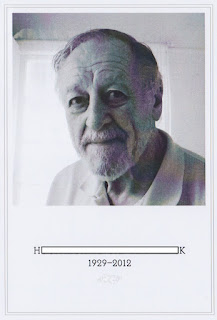The 'order of service' can be called many things, for example the Catholics would refer to it as a "mass book". Despite the many names it is always the same thing at every funeral. There may be slight variations but basically it is the booklet which lists what is to happen at the funeral and gives some information about the deceased or their family.
One thing I noticed during my grandfathers funeral was how much effort and care was put into making the order of service. My aunt, who was organising it, wanted to get the working and design perfect. Which was a tricky task considering she had a couple of days to organise and print them off. After printing them off we all helped to fold them. Here again I noticed how much care was put into folding them, everyone made sure the folds were straight and crisp. For everyone the orders of service were very important and personal. This has made me realise how the order of service can be used to help deal with the loss of a loved one.
An issue I've realised with organising funerals is how little progress there appears to be. One can spend a week arranging and organising a funeral for their loved one and yet it does not feel like much gets done. Important and emotional decisions are made and yet there is nothing to show for it. For example when people pick a coffin it is usually through a book. They look through the book at the pictures and pick the one they like. No different from how one would pick furniture out of a catalogue. This distances people from the significance and emotions of their decision. Then after all these decisions are made people do not see them enacted until the day of the funeral. Going back to the example of the coffin, it is not seen until the funeral. It is an emotional and expensive thing which is not seen until the end. This creates a sense of stagnation as though little progress has been made. That the decisions made have little impact. Which is not a good feeling for the family or friends.
Here is where the order of service can be used to counter this. The family can be directly involved in all aspects of the booklets. They can design them, print them and sort them. They can be involved throughout the process and see it develop first hand. As such this will help to create a sense of progress and make people feel involved in the funeral process.
Yet the order of service is so much more than this. It is a representative and physical part of the funeral and deceased. The order of service is treated as a physical part of the funeral process and is bound up with many emotions. The way my grandmother held the first printout was a great display of this. She held it with longing care. A sad smile slid slowly over her and she looked over the book for a while before handing it back. It was not just a book but a bit of her husband, one of the very last bits of him, and it was a bit of his funeral yet to come. In other words the order of service is an actual piece of the funeral process and the deceased. This is most obvious in the way that the order of service often has a picture the and dates of birth and death of the deceased.
Unlike many other parts this is one people can hold and keep. The coffin for example is possibly more important (emotionally and physically) but it cannot be taken home. It canot be kept and it is barely interacted with. On the other hand there is the order of service is something people can take and keep as long as they like. When working as an undertaker I found people really wanted an order of service, and that almost everyone kept them. Rarely where the orders of service left behind in the chapel and when they were left it was by the immediate family. This was because the family had been distracted by other things such as carrying the coffin and often left other personal belongings behind as well. Or because they had a copy or two at home and knew they could (and would) print more copies later.
It is also a piece that can be sent and given to others who did not attend the funeral. Thus it can make people who did not attend feel part of the funeral process. They were not able to go but could bring a bit of the funeral to them. I noticed this while working in the funeral industry, that many who could not go would ask the family for an order of service. Then at my grandfathers funeral I saw how the family overseas who could not make it were really happy to get an order of service. It's a really nice gesture that will make people feel involved and part of the event.
This post only covers the surface of the order of service. It is a very complex and intricate thing which is bound up with a lot of emotions and meanings. This makes it the perfect thing to help people deal with the upcoming funeral and death of a loved one. So pay attention to the order of service and try to involve people in its creation.
~~





























